(Photo by Doug Murray/Icon Sportswire)
During yesterday’s (September 30th) game between the Miami Marlins and New York Mets, Marlins starter Sandy Alcantara used a pitch tunnel, spread velocity, and located his pitches early in the count in an attempt to disrupt Todd Frazier’s timing. I’m going to take a look at the first two pitches of the eight-pitch at-bat and break down how this is a great way to attack a hitter using the tools that Alcantara demonstrated with his fastball and slider.
Alcantara started Frazier off with a 97 MPH four-seam fastball roughly middle inside the strike zone; this is his average velocity on fastballs through his young career. Frazier, doing his homework, should be ready to time that velocity, give or take an MPH. Against right-handed hitters, Alcantara has thrown 32 first-pitch four-seam fastballs in locations detailed in Chart 1 below.
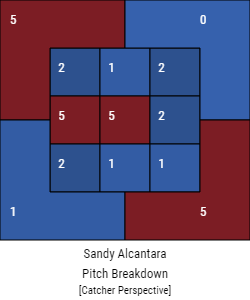
CHART 1
Alcantara goes mostly middle, up and in, and down and away. Furthermore, looking at Chart 2, we see that over 60% of first pitches are either a fastball or slider with a leaning toward the fastball.
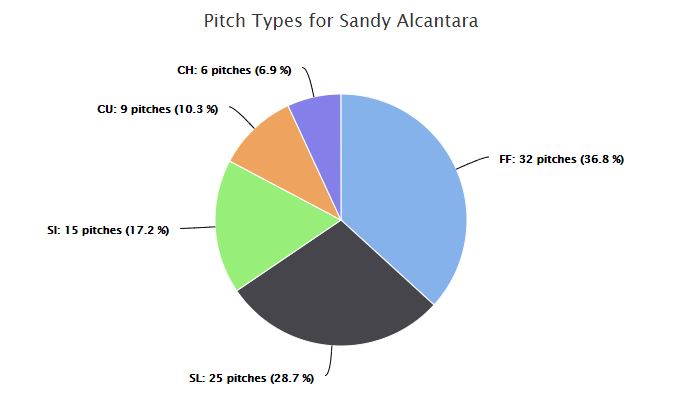
CHART 2
Since the start of the 2017 season, Frazier has swung at the first pitch 23% of the time. He offered at the fastball located where Alcantara typically places his first pitch fastballs to right-handed hitters. Everything checked out; location and velocity (97 MPH).
But Frazier swung and missed; he was also pretty late. How did this happen if Frazier is timing a fastball at the velocity that the radar gun recorded? Let’s take a look at the gif below.
[gfycat data_id=”NeglectedSkeletalAustraliankestrel”]
Before we break it down, let’s look at the swing mechanics on the fastball. Frazier tried to cheat by pulling his hands in (Image 1) and, at the point where he expected to make contact, we can tell his body is bailing out and the potential contact point is closer to the handle than the barrel (Image 2).
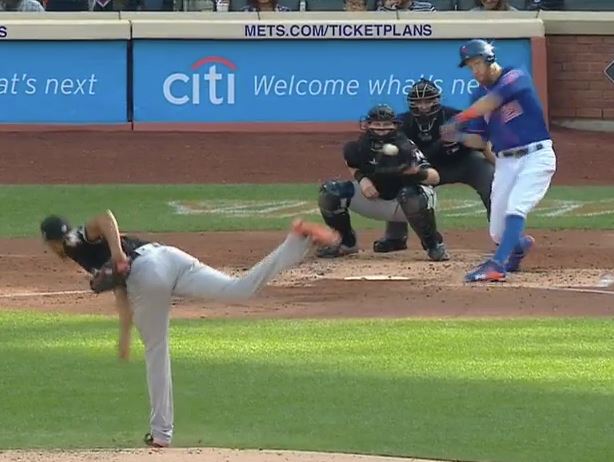
IMAGE 1
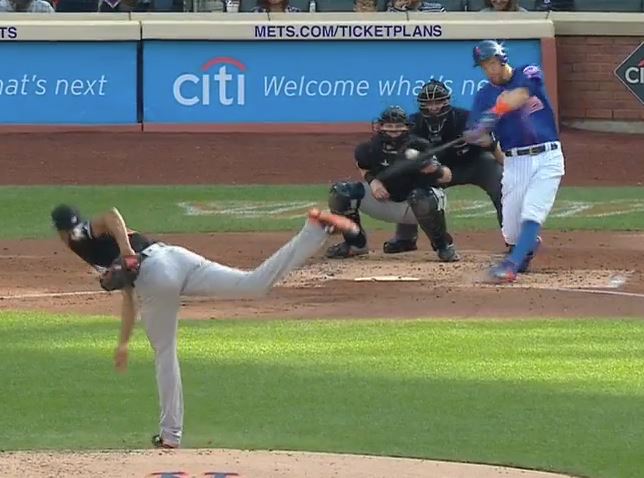
IMAGE 2
Frazier was late because he didn’t account for the pitch’s Effective Velocity. The location of the fastball applies one time unit of speed, thereby increasing the radar velocity of 97 MPH to about 100 EvMPH. You can see in the images that Frazier wasn’t too late but late nonetheless. Had he somehow made contact on the pitch, we’d likely have seen a weak ball in play (or foul).
As I did in my previous articles, I’m going to share the Effective Velocity chart so some of this information can make a little more sense.
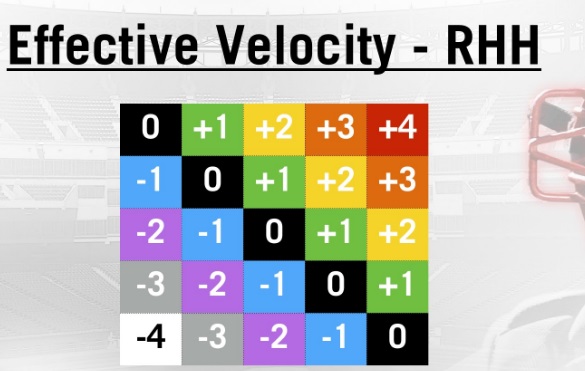
CHART 3
Looking where Alcantara placed pitch one, you see it was a decent location to attack. Since the pitch was borderline between up and in and middle in, Frazier’s whiff rate on pitches in that general spot is 15%
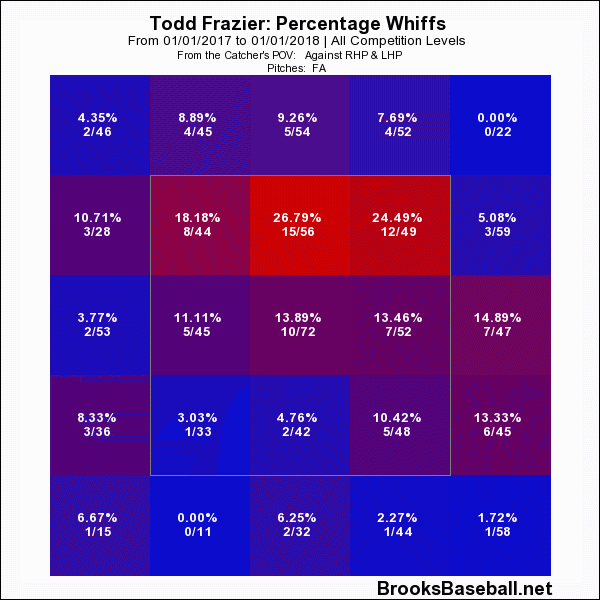
CHART 4
Moving on to pitch number two of the at-bat, we see Alcantara dropping in a ‘pressure pitch’ slider to Frazier. Barely out of the zone, he took the pitch and it ended up being called a strike.
[gfycat data_id=”GroundedUnderstatedFawn”]
The slider’s location created a loss of two time units which converts the radar reading of 88 MPH to 83 EvMPH; a 17 MPH velocity spread which is well beyond the 6 MPH spread threshold that Perry Husband discovered was where you see less than 50% of hard or barrelled contact.
You can tell by the way Frazier jerked at the pitch that he probably expected to see another fastball. This is due to the fact that Alcantara tunneled the two pitches. The below gif demonstrates how he was able to disguise the pitches on Frazier. What was even more effective in this case was a less than four-inch release extension difference between the pitches. Many pitchers release their slider (or other breaking pitches) a bit earlier than fastballs which can somewhat tip off a hitter as to what they are about to see.
[gfycat data_id=”FaithfulSomeCub”]
Somewhere between the recognition point and commit point, the pitches separate. That’s right where you want to be; the bare minimum for an (effective) pitch tunnel would be separation immediately following the recognition point. While it’s incredibly difficult to keep two different pitches on the same exact trajectory for a long period of time, you want to avoid roughly a two baseball-width spread as long as possible. Alcantara reached that point immediately prior the commit point on the slider. See Image 3 below with the black ‘x’ marking the fastball and the blue ‘x’ marking the slider.

IMAGE 3
For context, the recognition point is about 100 milliseconds after release while the commit point occurs 167 milliseconds before the ball reaches the plate.
It wasn’t necessary but Alcantara could have done even better to disguise what he was throwing by getting his release points even closer. Image 4 below shows his release points on all eight pitches he threw during that at-bat. Again, the black ‘x’ marks pitch one, the four-seam fastball, while the blue ‘x’ marks the slider.
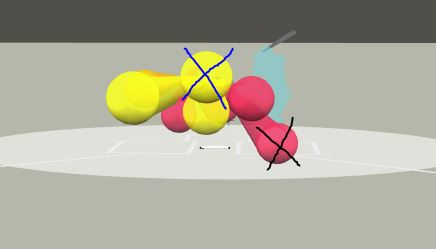
IMAGE 4
What you have here is the start of a great formula for attacking a hitter. Having great movement and high velocity certainly help but if you’re not locating your pitches correctly (or spreading your velocity enough) sooner or later a hitter is going to run into a pitch that one day he would completely miss and on another (in this case) he is able to connect for an extra-base hit.
Since we only wanted to concern ourselves with the first two pitches, as an epilogue, I’ll summarize how the rest of the at-bat went. Alcantara didn’t do enough to keep Frazier off-balance during the latter part this at-bat. He fouled off five straight pitches before finally correctly timing an 98 MPH four-seam fastball that Alcantara placed in the ‘null’ zone (meaning there are no time units to vary the effective velocity; see Chart 3). Frazier eventually guessed right and was able to time the four-seam fastball enough to drive the ball over the head of the outfielder. It should have been a lineout but the fielder was playing too shallow. Frazier was able to push a run across the board but was caught trying to stretch his double into a triple for an inning-ending out.
